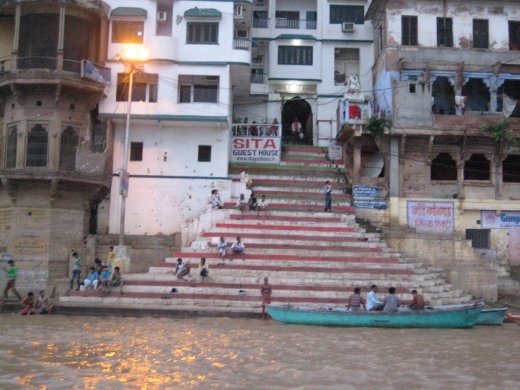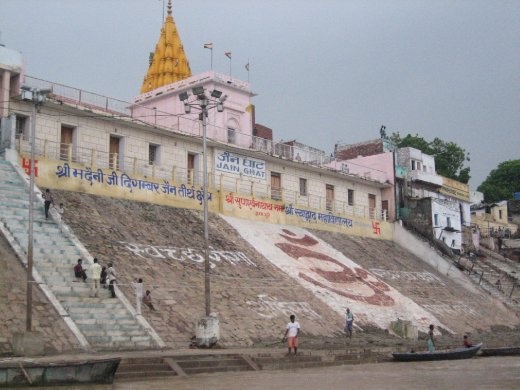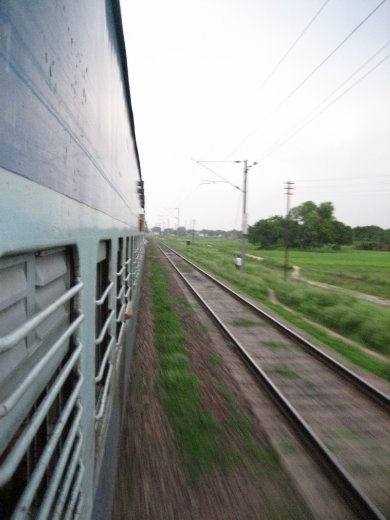



So trains in India
are an experience in and of themselves.
We arrived on the platform of the Lucknow
stations well ahead of schedule and waited for the Bareli Express to Varanasi well past the
scheduled departure time. That was
probably our fault if you think about the kind of schedules Indians keep in
general—by that I mean no schedule. Once
on the train it took some physical adeptness to squirm/launch myself into the
middle bunk. The AC3 car of the train
consists of 3 berths on each side of a compartment which is closed off by a
curtain. AC 3 is a luxury apartment
compared to the other seating on the train, where people are literally crammed
into every nook and cranny. It is an
amazing site to see, really. So after
the initial giddiness of simply being on a train wore off I attempted to
sleep. Which as most of you know I don’t
really sleep well to begin with so let’s just say I laid in my bunk (no sitting
up or you hit your head) for about 7 hours.
It really sounds a lot worse than it was. I would not be averse to doing it again let’s
put it that way J After a night of “rest” we were awoken by the
train conductor saying we had arrived in Varanasi, good thing Varanasi was the
last stop or we could have ended up only god knows where! So we sluggishly removed ourselves from the
train and shuffled towards the auto rickshaws.
After a bit of haggling by Shibani we were on our way. We arrived at Palace on the Ganges (by the
grace of god, these rickshaw drivers really are insane in Varanasi) on Asi Ghat
around 7am, had a delightful breakfast of aloo parathas, quickly showered, and
were out of the hotel by 9:30am.
Once out we walked along the ghat as far as we could before
the height of the river forced us to higher ground. There we met two locals who proceeded to take
us through the twisting streets of Varanasi
to the many temples that lay among them.
History break: Varanasi is the oldest
city in India it has gone
through 3 name changes: Kashi, Benaras (Banaras), and Varanasi.
Our “guides” told us the city itself contains over 2,500 temples. It is an extremely holy site for Hindus and
Buddhists. Sarnath, which we visited on
Sunday, is apparently were Buddha first delivered his 8-fold path message of
enlightenment to his followers. The
Ganges, or Ganga, River holds significance for
Hindus, it is believed that if you die here you basically go straight to
heaven—no pit stops.
Back to our walk. We
saw so many temples they all seem to blend together, but I’ll do my best to
separate them. First we saw the Water
Temple (Temple of Fertility—it has these steps leading down to the river and
women who are having trouble conceiving walk down the steps and bathe in the
water—I stayed out of that one. Also the
water is said to wash away your sins).
From there we followed our guides through the streets to the Tulsi Temple
(for the gods Ram & Krishna), the Durga
Temple, the Hanumaan or Sankata Mochan
or Monkey Temple.
The Monkey
Temple was crowded with
people and monkeys. At this temple you
buy sweets called La dulce and offer them to the god, the are blessed and then
given back to you to eat. At this temple
old Indian women nearly plowed through us to have their offerings blessed while
others sat cross legged chanting amid the chaos, and monkeys walked around
ignoring the humans. After Hanumaan we
walked the dark, narrow streets of the Sham Shan ghat or cremation ghat. The “untouchables” (lowest caste in India) cremate
people along the river here. There was a
pyre burning while we were there and you felt a kind of heaviness about the
air, that wasn’t due to the humidity.
From there we moved on to the Shiva temple on Kadar Ghat, there was no
electricity and we made our way through the puddles to little rooms receiving
blessings and delivering offerings to the god of destruction. I will say I found the temples to be the most
interesting part of my trip to Varanasi. At almost every turn there is someone with a
red or white dot on their forehead that he or she received from a blessing at a
temple. It is almost as involuntary as
breathing for the people there. There is
a great amount of ritual involved and I will say that I tried to keep up and be
sensitive to people’s religion (like entering a temple only with your right
foot, touching statues and receiving offerings only with your right hand,
donating a sufficient amount of rupees—no religion is without its “charity”),
but it was the most alienating and accepting feeling at the same time. There go the Indian contradictions
again. Alienated because of how foreign
the customs were to me and accepted because of the willingness of strangers to
include me in their faith.
So after our 3 ½ hour journey we were ready for lunch. We politely dismissed our guides, offering
them payment which they would not accept (they said they believed in knowledge
transfer—I choose to believe they were telling the truth. They bought me flowers for my birthday so I
will erase any possible ill intentions on their part J ), and headed to
Orchids for lunch. Our rickshaw driver
got lost in terrible heat and humidity, poor guy, but we got a mini tour of the
crowded city along the way which was kind of nice. After lunch we went to BHU (Banaras Hindu
University) a sprawling campus that
used to be one of the top universities in India. We made our way to yet another temple before
heading back to Asi ghat and our hotel for a bit of a rest before heading out
for the 7pm Aarti on the ghat. Well
rested, more or less, we made our way to the rivers edge where Shibani patiently
haggled with boat operators for 30 minutes before settling on Rs 300/ person to
take us to the Dasashwamedh Ghat to watch the Aarti. The boat ride down the Ganga
was quite beautiful with some incredible architecture along the way. I’m afraid the pictures really do not do it
justice. We arrived at the ghat just
before 7pm and made our way to the steps just past the shore to light candles
and set them adrift on the river. We
then settled in to watch the ceremony. The
Aarti is a 45 minute prayer ritual performed by Brahmin priests paying homage
to the river. They sound conch shells
and light these metal objects that are shaped kind of like snakes and chant
while swinging them around. Their
chanting is quite moving even from an outsiders perspective. Yet the moment you begin to feel the “spirit”
you are distracted by boats crowded with tourists facing the ghat only a few
meters away from the shore and sporting advertisements for Vodafone and Tata
Dacomo (cell phones). Not the most
spiritual sight. Nonetheless it was overall
an amazing sight to see.
After the Aarti people go up to receive offerings from the
priests (little sweets, cucumbers, guava—all objects that were blessed during
the ceremony) its similar to receiving communion. We weren’t fast enough for all the offerings,
but in another show of Indian hospitality a woman saw me and offered me some of
the sweets she received. We then made
our way up the steps to a throbbing market place (Times Square, but without the
neon light lights and cows) and found Raju a quick talking rickshaw driver to
take us back to our hotel. He gave us
the Indian price because Shibani is Indian J He proceeded to show me all of these
laminated cards which were reviews people had written about him all in Spanish no
less! He was quite amusing and
persistent, but made for an entertaining ride home. Once back we had a delicious meal at our
hotel, due to sheer exhaustaion, shared a warm beer and called it a night! Overall it was a most enjoyable 30th
birthday!